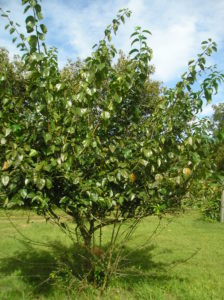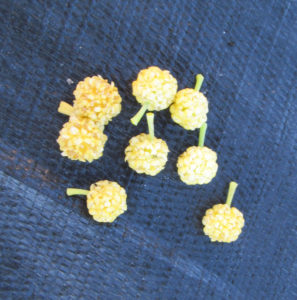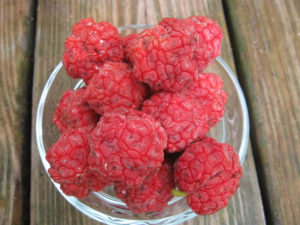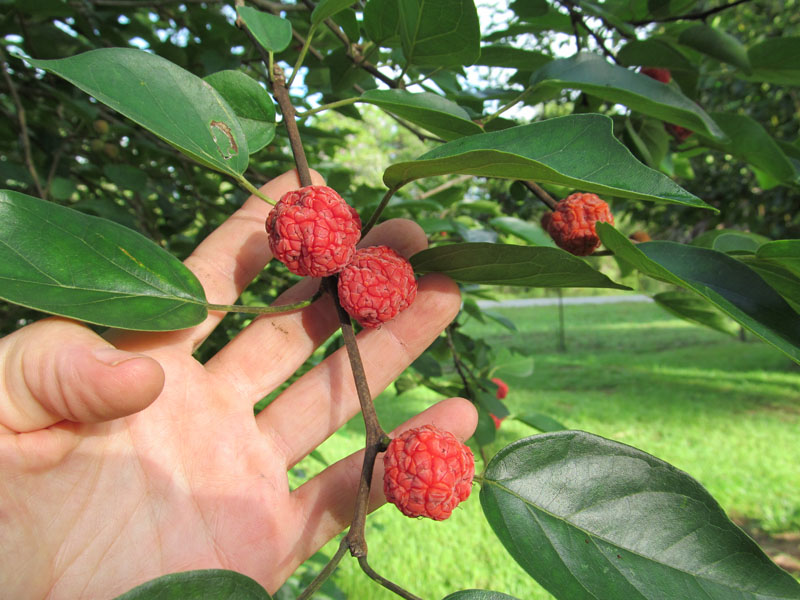Mandarin Melonberry is probably one of the most overlooked and remains still a jewel awaiting discovery. Mandarin melonberry, aka Che, has a long history of being grown for both food and medicine in China. Europeans carried the tree to France and England, and it arrived in the states over a century ago. The fruit was picked up and championed by George M. Darrow, a renowned small fruit breeder for the USDA.  The melon berry tree requires minimal care and has a tolerance of drought and poor soils similar to that of the related mulberry.
The melon berry tree requires minimal care and has a tolerance of drought and poor soils similar to that of the related mulberry.
The trees are quite cold-hardy and can withstand temperatures of -20° F. They leaf out and bloom late in spring, and are rarely caught by a late spring freeze. The trees adapt and fruit well from New York to Florida, zones 6-9. We have found the melon berry to love a wide range of soils, really anything but a wet spot will do. It does require some summer heat to ripen the fruit, so areas like the Pacific Northwest are not good choices. Plants started on their own roots or grown from seed can be a shrubby suckering mess in the garden, and are often very thorny. By grafting the melon berry onto an Osage orange a superior single-trunk fruit tree is created The tree is quite attractive in the landscape. Grafted trees remain small, rarely growing larger than 15 feet tall. Beautiful in fruit, it remains free of disease-free throughout the growing season. Melonberry is a great choice for growers that want to grow their fruit organically.
 The secret sex life of the melon berry. This is truly an odd creature when it comes to getting pollinated. The trees are either mostly male or mostly female, it has been observed that male trees will set some female flowers, and some females will set male flowers. Really, could it get any more confusing? Over time varieties have been selected that seem to bear well without a pollinator. Pollination of a male will help the trees to bear heavier fruit loads, but the pollinated fruit does tend to have some small seed.
The secret sex life of the melon berry. This is truly an odd creature when it comes to getting pollinated. The trees are either mostly male or mostly female, it has been observed that male trees will set some female flowers, and some females will set male flowers. Really, could it get any more confusing? Over time varieties have been selected that seem to bear well without a pollinator. Pollination of a male will help the trees to bear heavier fruit loads, but the pollinated fruit does tend to have some small seed.
For those growers that are plagued with bird issues, this is a good choice, as the birds seem unaware of the fruit, and we are able to harvest without sharing. Varieties differ in their thorniness, ripening times and flavor. We find Darrow to be a reliable fruiter without a pollinator and the fruit is large. Trees are nearly thornless. Norris is a new variety to fruit for us, it has excellent flavor, trees do have a few small thorns. JF Female is one of the best for size and flavor, very sweet!. The fruit should be allowed to fully ripen on the tree, and are harvested by picking like raspberries when they have a dull purplish blush to the fruit. Learning to pick when ripe will reward you with a soft, chewy, super-sweet fruit. The fruit has no acidity, the flavor is sweet and melon-like, reminiscent of cantaloupe mixed with watermelon. 
Once harvested melonberry keeps quite well, the fruit will store for a couple of weeks in a tightly shut container. The fruit should not be washed until ready to use. Really anything you can think of that you would use melon-like fruit in works well with melon berry. Fruit salads mixed with tangier fruit like tangerines, blueberries, and peaches are delicious. The low acidity of the fruit works well in smoothies, we really like it with blended with blueberries, vanilla ice cream, and almonds. Juice it and work it into cocktails and fruit punches; melon berry mimosas, anyone? My next experiment is to roast them. Many fruits are great slowly roasted with honey. It changes the character greatly and works well for topping ice cream. I really can’t wait for the new crop!

